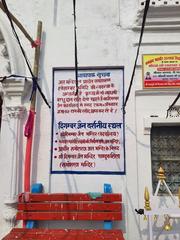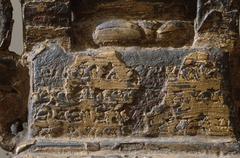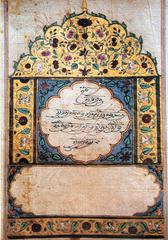
Visiting Jal Mandir: Hours, Tickets, and Travel Tips
Date: 24/07/2024
Introduction
Nestled in the serene town of Pawapuri in Bihar, India, Jal Mandir stands as a testament to the rich spiritual and architectural heritage of Jainism. Known as the ‘Water Temple,’ this iconic structure is not only a place of worship but also a symbol of tranquility and devotion. Dedicated to Lord Mahavira, the 24th Tirthankara of Jainism, Jal Mandir marks the site where he attained Nirvana around 527 BCE. This temple, surrounded by a large pond filled with lotus flowers, attracts thousands of pilgrims and tourists annually, drawn by its historical significance and serene beauty. Jal Mandir is an exquisite example of Jain architecture, featuring intricate carvings and a meticulously planned layout that reflects the balance and harmony in the universe. As one of the most revered pilgrimage sites for Jains, visiting Jal Mandir offers a unique opportunity to delve into India’s spiritual and cultural tapestry. This comprehensive guide aims to provide all the essential information for a memorable visit, including historical insights, architectural details, visitor tips, and nearby attractions. (Wikipedia, Incredible India, Explore Our India)
Table of Contents
- Introduction
- Historical Background
- Architectural Significance
- Cultural and Religious Significance
- Visitor Tips
- Preservation Efforts
- FAQ
- Conclusion
Historical Background
Jal Mandir, located in Pawapuri, Bihar, is a significant Jain temple that holds immense historical and religious importance. This temple is dedicated to Lord Mahavira, the 24th Tirthankara of Jainism, who attained Nirvana here around 527 BCE. The temple is built on the site where Lord Mahavira was cremated, and it is surrounded by a large water tank filled with lotus flowers. The temple’s name, ‘Jal Mandir,’ translates to ‘Water Temple,’ aptly describing its unique setting.
Architectural Significance
Design and Structure
The Jal Mandir is an exquisite example of Jain architecture, characterized by its simplicity and elegance. The temple is constructed using white marble, which gives it a serene and pristine appearance. The structure is relatively small but intricately designed, reflecting the architectural brilliance of the era. The temple stands on a rectangular platform in the middle of a large pond, accessible via a 600-foot-long stone bridge. This bridge not only adds to the temple’s aesthetic appeal but also symbolizes the spiritual journey towards enlightenment.
Intricate Carvings
One of the most striking features of Jal Mandir is its intricate carvings. The temple walls and pillars are adorned with detailed carvings depicting various scenes from Jain mythology and the life of Lord Mahavira. These carvings are not just decorative but also serve as a medium to convey religious teachings and stories. The artisans’ skill is evident in the precision and detail of the carvings, making the temple a visual delight for visitors.
Symmetry and Geometry
Jain architecture is known for its emphasis on symmetry and geometric patterns, and Jal Mandir is no exception. The temple’s layout is meticulously planned to ensure perfect symmetry, which is believed to represent the balance and harmony in the universe. The geometric patterns on the floors and ceilings are not only aesthetically pleasing but also hold symbolic meanings related to Jain cosmology.
Cultural and Religious Significance
Pilgrimage Site
Jal Mandir is one of the most revered pilgrimage sites for Jains. Every year, thousands of devotees visit the temple to pay their respects to Lord Mahavira and seek spiritual solace. The temple’s serene environment, coupled with its religious significance, makes it an ideal place for meditation and reflection. The annual Mahavir Jayanti festival, celebrating the birth of Lord Mahavira, attracts a large number of pilgrims and tourists, adding to the temple’s cultural vibrancy.
Rituals and Ceremonies
The temple is a hub of various religious rituals and ceremonies. Daily prayers, known as ‘Aarti,’ are performed in the morning and evening, accompanied by the chanting of Jain hymns. Special ceremonies are held during significant Jain festivals, such as Paryushana and Diwali, which are marked by elaborate rituals and community gatherings. These ceremonies provide a glimpse into the rich cultural and religious traditions of Jainism.
Visitor Tips
Best Time to Visit
The best time to visit Jal Mandir is during the winter months, from October to March, when the weather is pleasant and conducive for sightseeing. The temple is open to visitors throughout the year, but it is advisable to avoid the monsoon season (July to September) due to heavy rainfall, which can make the surrounding areas slippery and difficult to navigate.
Visiting Hours and Tickets
Jal Mandir is open to visitors from 6:00 AM to 7:00 PM daily. There is no entry fee for the temple, making it accessible to everyone. However, donations are welcome and help in the maintenance and preservation of the temple.
Dress Code and Etiquette
Visitors are expected to dress modestly when visiting Jal Mandir. It is recommended to wear traditional Indian attire or clothing that covers the shoulders and knees. Footwear must be removed before entering the temple premises as a mark of respect. Photography is generally allowed, but it is advisable to seek permission from the temple authorities before taking pictures, especially during religious ceremonies.
Accessibility
Jal Mandir is well-connected by road and can be easily reached from major cities in Bihar, such as Patna and Nalanda. The nearest airport is Lok Nayak Jayaprakash Airport in Patna, approximately 90 kilometers away. From Patna, visitors can hire a taxi or take a bus to Pawapuri. The temple is also accessible by train, with the nearest railway station being Rajgir, located about 20 kilometers from Pawapuri.
Nearby Attractions
While visiting Jal Mandir, tourists can also explore other nearby attractions in Pawapuri and the surrounding areas. Some notable sites include:
- Samosharan Temple - Another significant Jain temple in Pawapuri, believed to be the place where Lord Mahavira delivered his last sermon.
- Nalanda University - An ancient center of learning and a UNESCO World Heritage Site, located about 30 kilometers from Pawapuri. The ruins of Nalanda University offer a fascinating glimpse into India’s rich educational heritage.
- Rajgir - A historic town known for its hot springs, ancient temples, and scenic landscapes. Rajgir is also an important pilgrimage site for Buddhists and Jains.
Preservation Efforts
Conservation Initiatives
Efforts to preserve Jal Mandir and its surroundings are ongoing, with various government and non-government organizations involved in conservation activities. The Archaeological Survey of India (ASI) plays a crucial role in maintaining the temple’s structural integrity and ensuring its preservation for future generations. Regular maintenance work, including cleaning and restoration of the marble structure, is carried out to protect the temple from weathering and decay.
Community Involvement
The local community and Jain organizations actively participate in the preservation and promotion of Jal Mandir. Various awareness programs and initiatives are undertaken to educate visitors about the temple’s historical and cultural significance. Community-led efforts also focus on maintaining the cleanliness and sanctity of the temple premises, ensuring a pleasant experience for all visitors.
FAQ
What are the visiting hours for Jal Mandir? Jal Mandir is open to visitors from 6:00 AM to 7:00 PM daily.
How much are the tickets for Jal Mandir? There is no entry fee for visiting Jal Mandir. However, donations are welcome and help in the maintenance and preservation of the temple.
What is the best time to visit Jal Mandir? The best time to visit Jal Mandir is during the winter months, from October to March.
How can I reach Jal Mandir? Jal Mandir is well-connected by road and can be easily reached from major cities in Bihar. The nearest airport is Lok Nayak Jayaprakash Airport in Patna, approximately 90 kilometers away. The nearest railway station is Rajgir, about 20 kilometers from Pawapuri.
Conclusion
Jal Mandir in Pawapuri, Bihar, stands as a testament to the architectural brilliance and spiritual heritage of Jainism. Its serene setting, intricate design, and religious significance make it a must-visit destination for those seeking a deeper understanding of India’s cultural and spiritual heritage. By preserving and promoting this architectural marvel, we ensure that future generations can continue to appreciate and be inspired by its timeless beauty and spiritual essence. Plan your visit wisely, respect local customs, and take the time to explore nearby attractions to make the most of your trip. For more travel guides and tips, download our mobile app Audiala, check out other related posts, or follow us on social media for more updates. (Thrillophilia, Bodhi Bihar, TFN International)
References
- Wikipedia, 2024, Jal Mandir
- Incredible India, 2024, Jal Mandir
- Explore Our India, 2024, Jal Mandir
- Thrillophilia, 2024, Jal Mandir
- Bodhi Bihar, 2024, Jal Mandir
- TFN International, 2024, Nalanda



